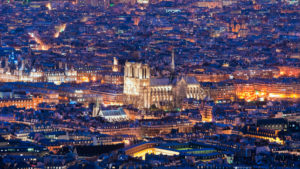Notre Dame Cathedral, on the Ile de la Cité, sits on the Seine between the Left and Right banks of Paris – literally and figuratively the center of the city, and of France.
As NPR notes, it is “convenient and inescapable for the estimated 13 million people who visit it every year. Just outside, a Point Zero marker measures the distance to everything else in France. And Notre Dame is there in more than 850 years of French history: in paintings, daguerreotypes, songs, novels, war photos, awed selfies.”
A Difficult Choice Saved the Structure
On Monday evening as the raging fire engulfed the wood and metal frame atop Notre Dame, Paris’s firefighters likely saved the cathedral’s structure with a difficult decision, the WSJ reports. “They gave up on the roof and turned to saving the cathedral’s Gothic towers,” which allowed firefighters to focus their energies on the structurally important belfries.
Water Pumped from Seine Helped Create a Water Wall
Inside the 225-foot north tower, flames were beginning to lick at the wooden belfry, which not only holds its massive bells but also helps support the tower’s stone arches. A fire-brigade commander directed additional heavy water cannons mounted on 130-foot arms to douse the tower and create a water wall to protect it and the south tower from the blaze, officials said Wednesday.
How much Monday’s fire at Notre Dame damaged the Cathedral’s stone superstructure will not be clear for a long time. Its spire has collapsed and there is charred rubble inside. But the blackened structure, along with its two towers, remains standing,
When limestone masonry is subjected to flames for a prolonged time, the strength of the limestone is compromised. Michael J. Lewis. who teaches architectural history at Williams, explains in the WSJ the magnitude of the loss. Notre Dame was not a pristine piece of medieval art, he notes. Furthermore, after the Revolution and the rise of secularism, the cathedral was in desperate need of restoration.
The Uncommon Quality of Notre Dame
Many will have been surprised to learn that a Gothic cathedral can burn. But as the recent destruction of the Glasgow School of Art reminds me, there is a great deal of combustible material in a masonry building. We think of the great Gothic cathedrals, with their slender flying buttresses, as essays in stone construction, but they were always capped by steep timber roofs. These used to burn from time to time before Benjamin Franklin invented the lightning rod, but as late as 1836 Chartres Cathedral lost its roof (which was replaced with one of the first iron trusses).
Exceptional Homogeneity in Its Patchwork Architecture
The building of a Gothic cathedral took centuries, not years, and most are a patchwork of different styles by different architects. But Notre Dame had an unusual degree of unity. Begun in 1163 and not completed until about 1250, it had at least three different designers, each of whom worked to maintain its spatial and rhythmic clarity. And although its construction spanned the muscular Early Gothic to the graceful High Gothic, its design is one of exceptional homogeneity.
Notre Dame the Focus of Mob Violence
During the French Revolution it was the focus of mob violence, and the great Gallery of Kings above its west facade was thrown down (in the mistaken belief that these were French, not biblical kings). By this time, much of the stained glass had been removed and replaced with clear glass in the name of brightening the interior. In the wake of its revolutionary secularization, the cathedral was desperately in need of restoration. Help came in the form of literature in 1831, when Victor Hugo wrote his “The Hunchback of Notre-Dame,” which in French is named after the cathedral, “Notre-Dame de Paris.” The novel aroused a swell of public sentiment for the ravaged building.
The Eiffel Tower a Child of Notre Dame
What has been lost is more than just a great building. Like the Eiffel Tower, Notre Dame was the symbol not just of Paris but all of France. And like the Eiffel Tower, it was a statement of proud and soaring ambition expressed in the most progressive technology available. In a sense, the Eiffel Tower is itself a child of Notre Dame, concentrating its weight on delicate iron girders just as the cathedral directed its stresses onto its exquisitely tapered flying buttresses.
Read more here.
If you’re willing to fight for Main Street America, click here to sign up for the Richardcyoung.com free weekly email.





